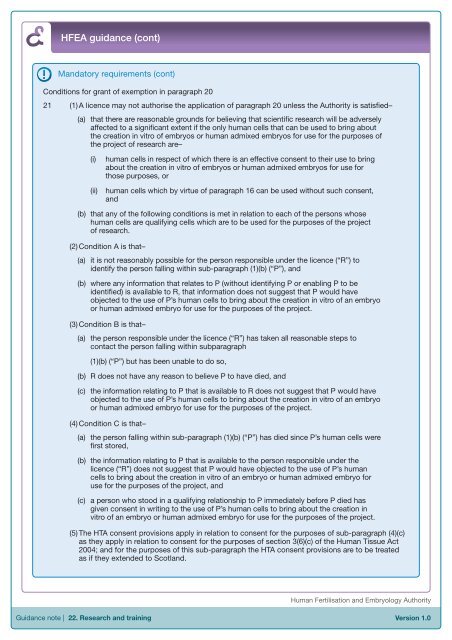Eighth Edition - R.3 - Human Fertilisation & Embryology Authority
Eighth Edition - R.3 - Human Fertilisation & Embryology Authority
Eighth Edition - R.3 - Human Fertilisation & Embryology Authority
Create successful ePaper yourself
Turn your PDF publications into a flip-book with our unique Google optimized e-Paper software.
HFEA guidance (cont)<br />
Mandatory requirements (cont)<br />
Conditions for grant of exemption in paragraph 20<br />
21 (1) A licence may not authorise the application of paragraph 20 unless the <strong>Authority</strong> is satisfied–<br />
(a) that there are reasonable grounds for believing that scientific research will be adversely<br />
affected to a significant extent if the only human cells that can be used to bring about<br />
the creation in vitro of embryos or human admixed embryos for use for the purposes of<br />
the project of research are–<br />
(i)<br />
(ii)<br />
human cells in respect of which there is an effective consent to their use to bring<br />
about the creation in vitro of embryos or human admixed embryos for use for<br />
those purposes, or<br />
human cells which by virtue of paragraph 16 can be used without such consent,<br />
and<br />
(b) that any of the following conditions is met in relation to each of the persons whose<br />
human cells are qualifying cells which are to be used for the purposes of the project<br />
of research.<br />
(2) Condition A is that–<br />
(a) it is not reasonably possible for the person responsible under the licence (“R”) to<br />
identify the person falling within sub-paragraph (1)(b) (“P”), and<br />
(b) where any information that relates to P (without identifying P or enabling P to be<br />
identified) is available to R, that information does not suggest that P would have<br />
objected to the use of P’s human cells to bring about the creation in vitro of an embryo<br />
or human admixed embryo for use for the purposes of the project.<br />
(3) Condition B is that–<br />
(a) the person responsible under the licence (“R”) has taken all reasonable steps to<br />
contact the person falling within subparagraph<br />
(1)(b) (“P”) but has been unable to do so,<br />
(b)<br />
(c)<br />
R does not have any reason to believe P to have died, and<br />
the information relating to P that is available to R does not suggest that P would have<br />
objected to the use of P’s human cells to bring about the creation in vitro of an embryo<br />
or human admixed embryo for use for the purposes of the project.<br />
(4) Condition C is that–<br />
(a) the person falling within sub-paragraph (1)(b) (“P”) has died since P’s human cells were<br />
first stored,<br />
(b) the information relating to P that is available to the person responsible under the<br />
licence (“R”) does not suggest that P would have objected to the use of P’s human<br />
cells to bring about the creation in vitro of an embryo or human admixed embryo for<br />
use for the purposes of the project, and<br />
(c)<br />
a person who stood in a qualifying relationship to P immediately before P died has<br />
given consent in writing to the use of P’s human cells to bring about the creation in<br />
vitro of an embryo or human admixed embryo for use for the purposes of the project.<br />
(5) The HTA consent provisions apply in relation to consent for the purposes of sub-paragraph (4)(c)<br />
as they apply in relation to consent for the purposes of section 3(6)(c) of the <strong>Human</strong> Tissue Act<br />
2004; and for the purposes of this sub-paragraph the HTA consent provisions are to be treated<br />
as if they extended to Scotland.<br />
<strong>Human</strong> <strong>Fertilisation</strong> and <strong>Embryology</strong> <strong>Authority</strong><br />
Guidance note | 22. Research and training<br />
Version 1.0

















